Marriages in Australia
You are in an archived section of the AIFS website
March 2022
Lixia Qu, Jennifer Baxter, Megan Carroll
Fewer putting a ring on it
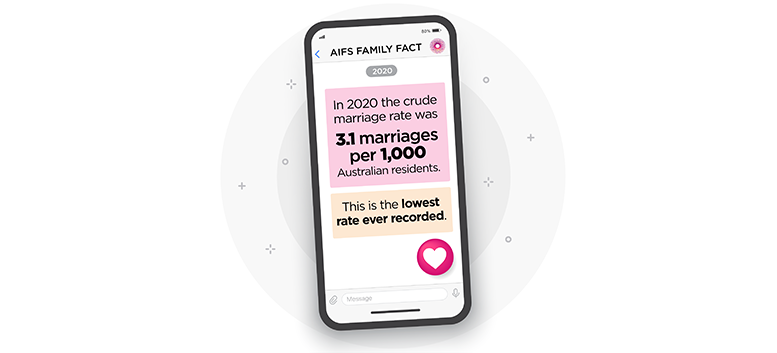
Although the Australian population has doubled in size since the early 1970s, the number of marriages registered each year has not increased over this time. The yearly number has instead fluctuated between 100,000 and 120,000 (Figure 1). The number of marriages registered in 2019 (113,815) was lower than in 1970 (116,066). The impact of the COVID-19 pandemic on marriages in 2020 is also evident (Figure 1). Lockdowns and restrictions led to wedding cancellations and the postponement of wedding plans.1 According to the Australian Bureau of Statistics (ABS), in 2020, there were only 78,989 registered marriages, representing a decline by 30% from 113,815 the previous year.
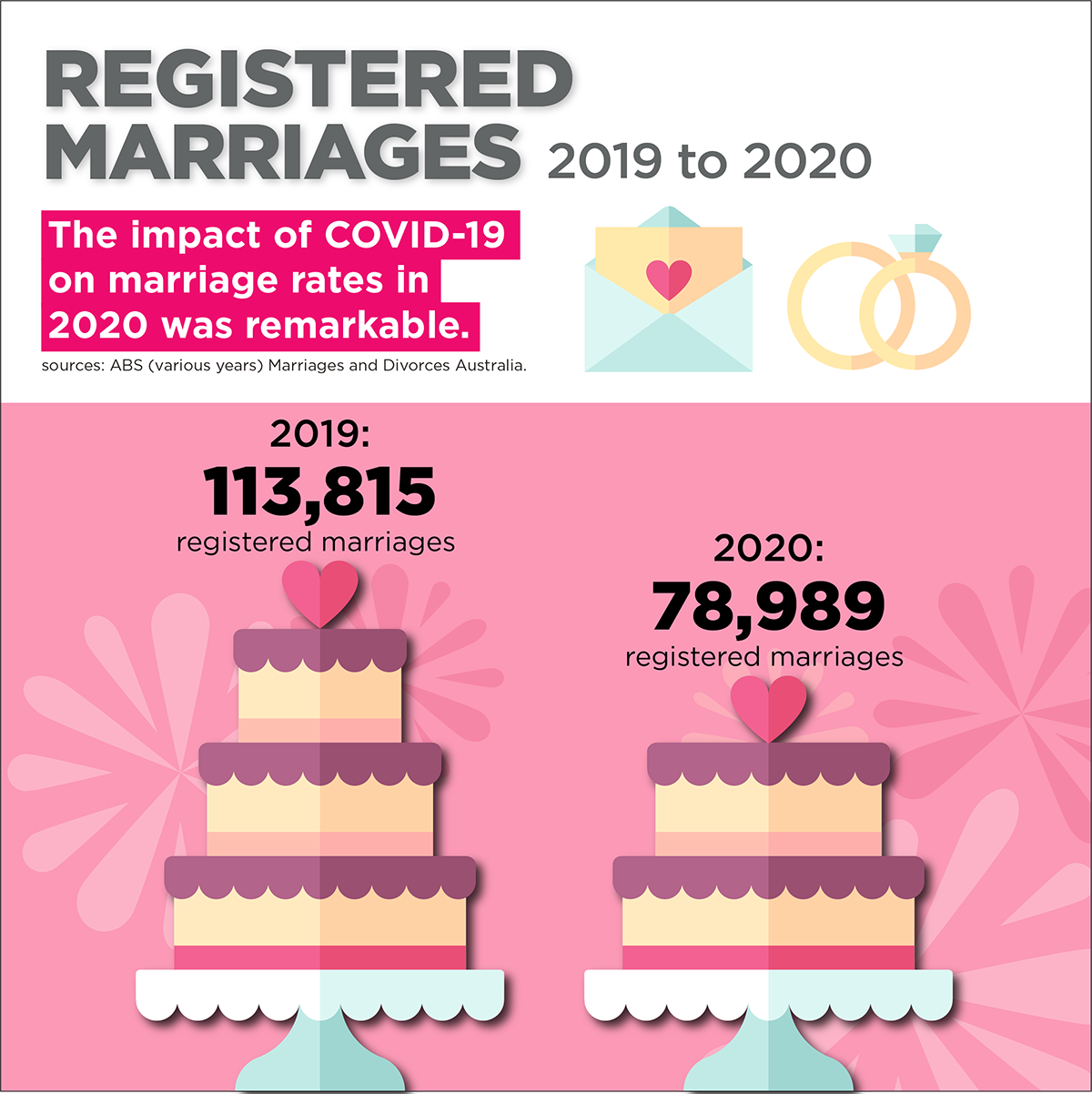
The crude marriage rate (the number of marriages registered in a year per 1,000 Australian residents) fluctuated across the first half of the twentieth century. The all-time high was in 1942. Following an increase in the 1960s, the rate began to fall steadily from 1970 until 2000. It then stabilised for a decade before falling again.
The fall in the marriage rate over the last half century has been influenced by a range of demographic and social changes, including extended time in pursuing education beyond Year 12 with increasing demands for a skilled workforce; increased labour force participation of women, especially mothers; the availability of the pill, which enabled a disconnection between marriage and childbearing; the rise in cohabitation, and a change in attitudes towards marriage. See Weston, Stanton, Qu, and Soriano (2001) for a discussion of social changes contributing to these trends.
As with the number of marriages, the crude marriage rate was especially low in 2020 because of the impact of COVID restrictions. In 2020 the rate was 3.1 marriages per 1,000 Australian residents, the lowest rate ever recorded.
Figure 1: Number of marriages registered and crude marriage rate, 1901–2020
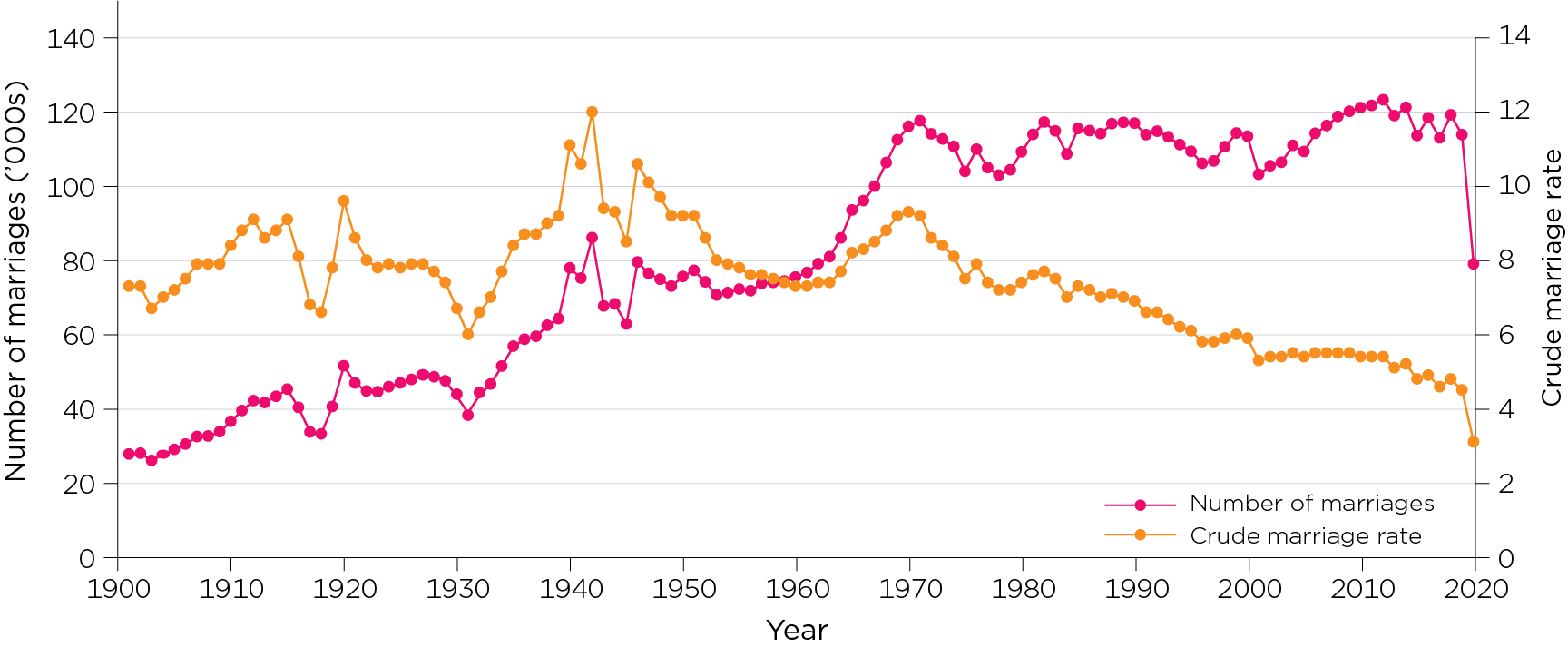
Notes: Crude marriage rate: number of marriages per 1,000 of estimated resident population at June for each reference year. Same-sex marriage was legalised in Australia in December 2017 and figures from 2018 onwards include same-sex marriages.
Source: ABS, (various years), Marriages and Divorces Australia
State variation in crude marriage rates
The effects of the COVID pandemic on marriage numbers are most apparent when viewed by state and territory, given the varied experiences of COVID-related restrictions across different parts of Australia in 2020. Figure 2 shows the state variation in crude marriage rates. While all states experienced a decrease in marriage numbers, Victoria experienced the largest decrease in this rate compared to previous years.
Aside from the impacts of COVID, this figure also shows that the crude marriage rates are typically lower in the two territories – the Northern Territory (NT) and the Australian Capital Territory (ACT) – compared to the states, and usually highest in New South Wales (NSW). In 2020 these patterns were different, although NT continued to have the lowest crude marriage rate overall.
Figure 2: Crude marriage rate by state, 2018–20

Note: Crude marriage rate: number of marriages per 1,000 of estimated resident population at June for each reference year.
Sources: ABS, (various years), Marriages and Divorces Australia
When do we marry?
There are seasonal patterns to when people get married. Figure 3 shows the number of marriages per month in Australia in 2020, compared to selected previous years. The number of marriages is typically higher around February–March and again around September–November.
The impacts of COVID on marriages can be seen in the number of weddings per month in 2020. The introduction of COVID restrictions in March 2020 had an immediate impact on the number of marriages, for example, with a dramatically lower number of marriages in April 2020 compared to April numbers in previous years. The 2020 April number was approximately 30% of the 2019 April number.
At a state level (data not shown – refer to ABS data) the impacts on marriages in the early months of the year were felt equally across Australia. In the latter half of the year, the marriage numbers had rebounded to above 60% of the previous year in most states, with numbers for Tasmania and the NT as high as 90%. Numbers for Victoria were the exception, where a second lot of COVID restrictions meant September had only 192 marriages registered, compared to 1,981 the previous September.
Figure 3: Number of marriages per month, 2010–20

Note: Variations in the number of weekends per month and the additional leap day in 2020 may contribute to some variation between years in the number of marriages each month.
Source: ABS, (various years), Marriages and Divorces Australia
First and later marriages
Out of the 78,989 registered marriages in 2020, 56,527 were first marriages for both partners (72%). For 17% of the marriages, it was a first marriage for one person but not the other. For 12% of the marriages, it was not a first marriage for either party.
These proportions are similar to those of recent years. In 2019, for example, 73% were first marriages for both, 16% a first marriage for one, and 11% remarriage for both.
Figure 4 shows the proportion of marriages that were first marriages for both partners since 1960. The proportions of first marriages were 85%–87% in the 1960s. This fell sharply to 71% in 1976 when the no-fault principle was introduced through the Family Law Act 1975 (Cth), allowing couples who filed for divorce in previous years to finalise their divorce and remarry. The rate of first marriages remained stable from the late 1970s to the mid-2000s (66%–67%), with a progressive increase in the following years and, from 2013, becoming stable again at 72%–73%.
Figure 4: First marriages as a proportion of all marriages, 1961–20

Sources: Commonwealth Bureau of Census and Statistics, (various years), Australian Demography Bulletin (ABS Catalogue 3141.0); ABS, (various years), Marriages Australia (Catalogue no. 3306.0); ABS, (various years), Marriages and Divorces Australia.
How old are we when we marry?
Figure 5 shows that between 1940 and the early 1970s, the median age at which men entered their first marriage fell by more than three years, from 26.5 years in 1940 to 23.4 years in 1974. The median age at first marriage for women also fell by a similar magnitude during this period, from 23.7 years in 1940 to 20.9 years in 1974. Since then, the median age at first marriage has increased for both men and women. For a discussion about these trends see Weston, Stanton, Qu, and Soriano (2001) and Weston and Qu (2014).
From the mid-1970s until 2018 there was a steady and ongoing increase for men and women in the median age at first marriage. This upward trend has not been apparent in the 2018, 2019 and 2020 statistics. In 2020 the median age of men was 30.6 years, and women 29.2 years. This is only slightly younger than the 30.7 years for men and 29.3 years for women in 2019. That is, while the pandemic led to a decline in the number of marriages and the crude marriage rate, the median age at first marriage remained similar. It is also worth noting that the gap in median age at first marriage between men and women has narrowed from 2.3 years in 1980, to 1.8 in 2000 and 1.4 years in 2019 and 2020.
The yearly statistics on median age at first marriage since 2018 may be affected by same-sex marriages, which were included in the official statistics following the amendments to the Marriage Act 1961 in December 2017 (see discussion below). As shown in the later section, median ages at first marriage were higher for same-sex marriages than all marriages, with this pattern being more apparent in 2018 than the subsequent two years. In addition, the proportion of marriages involving same-sex marriages was higher in 2018 than 2019 and 2020. The high median age at first marriage for men and women in 2018 might have been ‘pushed up’ somewhat by older same-sex couples who had wanted to marry being able to do so.
Figure 5: Median age at first marriage, 1940–2020
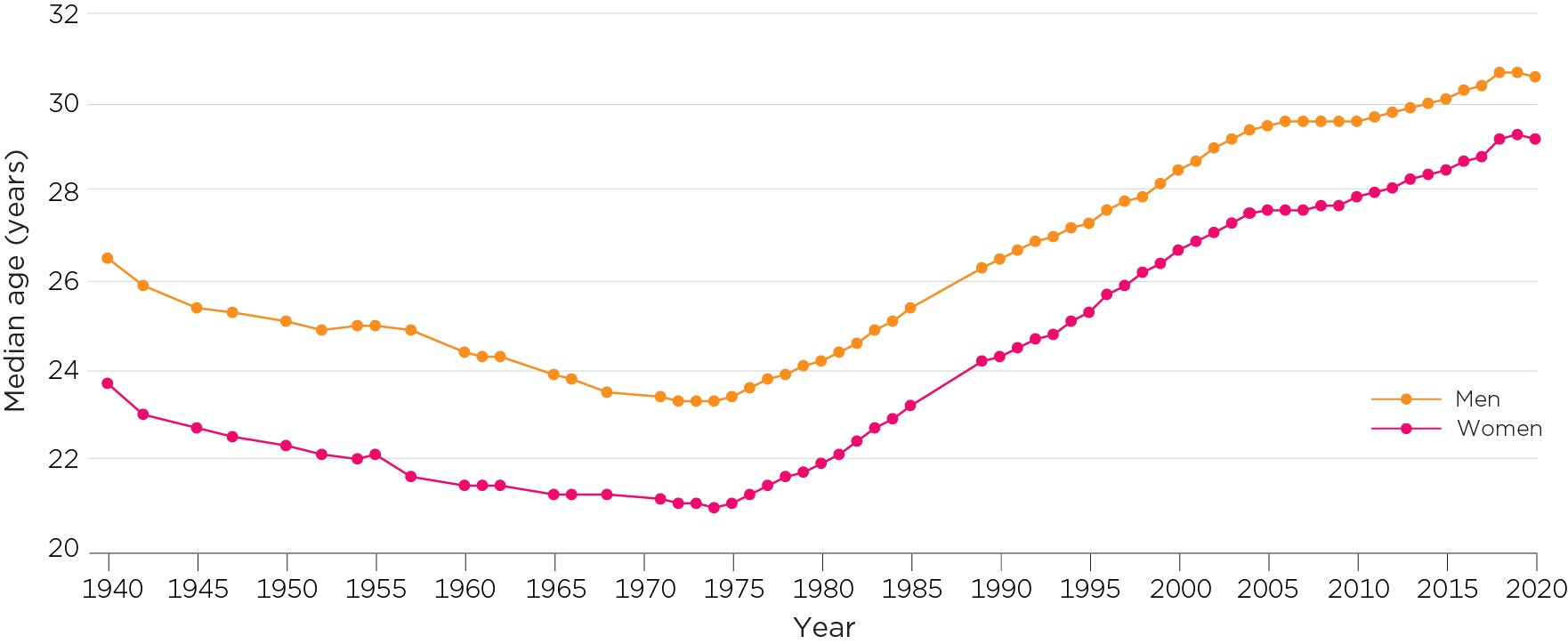
Sources: ABS, (various years), Marriages and Divorces Australia; ABS, (1997), Australian Social Trends (Catalogue No. 4102.0); ABS, Unpublished data.
Living together before marriage
Most couples now live together before getting married. This has increased greatly since the mid-1970s. In 1975, only 16% of marriages were preceded by cohabitation. By 2017, 81% of couples had been living together before getting married. (Data for more recent years are not available.)
Religious vs civil weddings
Marriages by civil celebrants are now much more common than those by ministers of religion, following a trend over recent decades that reversed the previous dominance of marriages by ministers of religion (Figure 6).
Figure 6: Marriages by celebrants and ministers of religion, 1902–2020
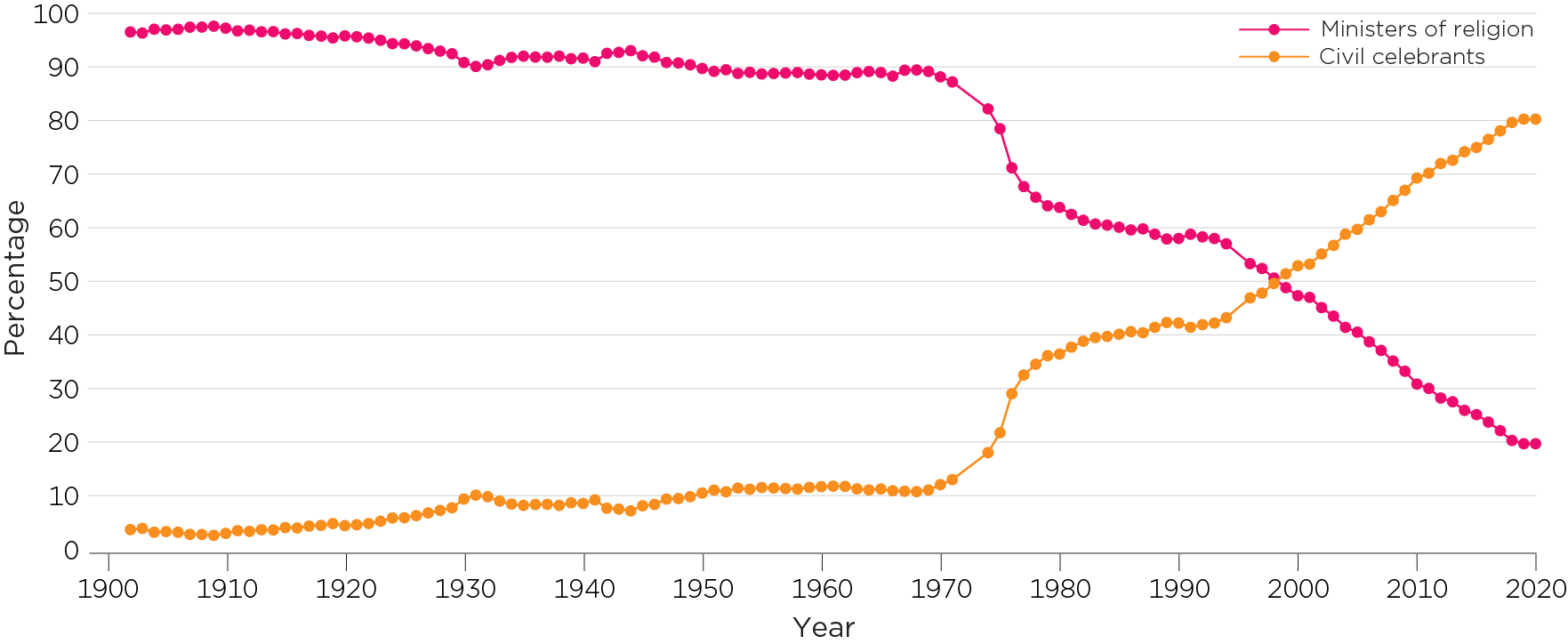
Sources: ABS, (various years), Marriages and Divorces Australia; Commonwealth Bureau of Census and Statistics, (various years), Australian Demography Bulletin (ABS Catalogue No. 3141.0)
In 1902, almost all marriages (97%) were performed by ministers of religion. However, by 2000, for the first time, there were more marriages performed by civil celebrants than by ministers of religion. By 2020, 80% of marriages were performed by civil celebrants. The proportion of marriages performed by civil celebrants has remained stable since 2018, including for 2020.
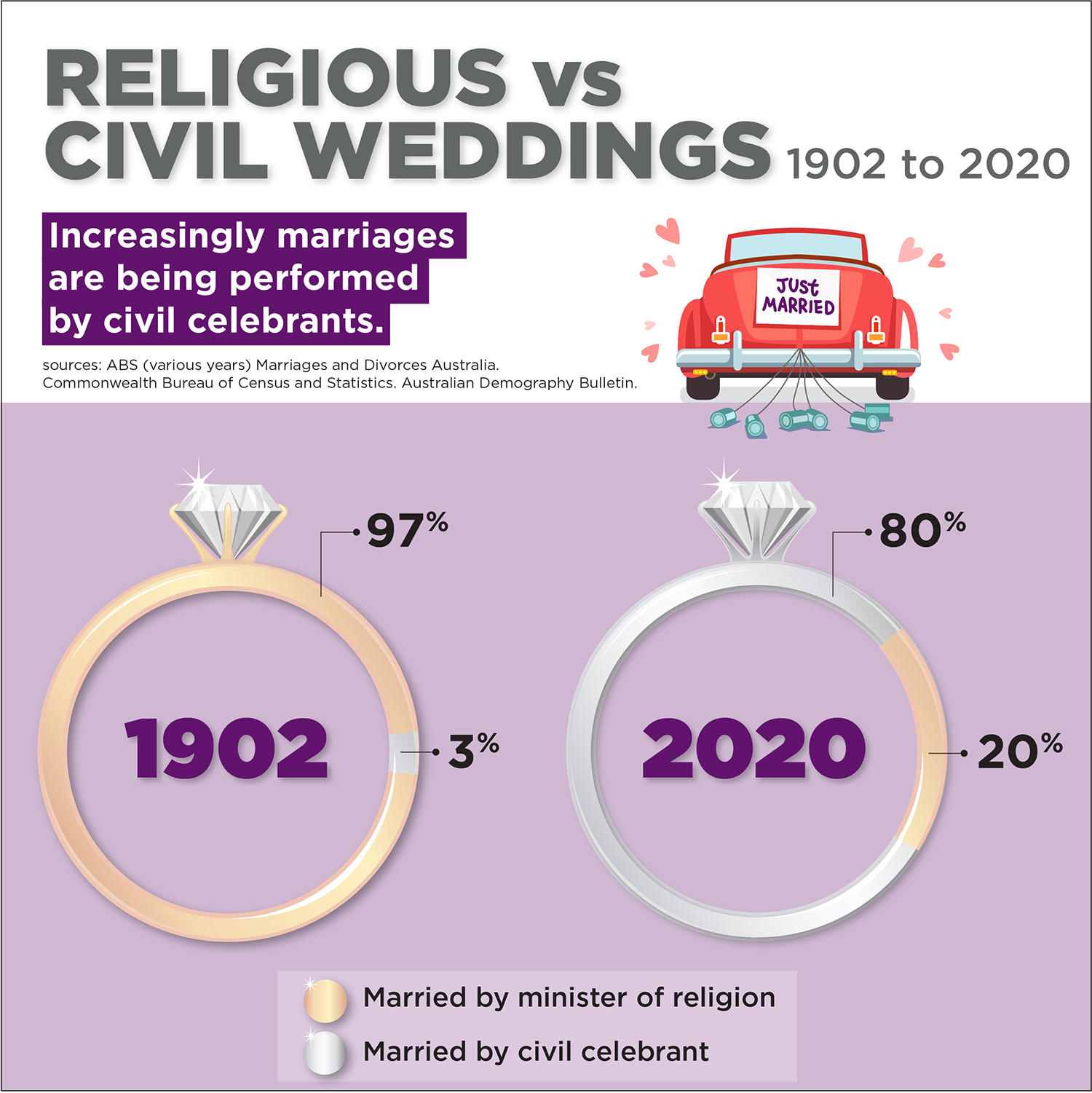
Same-sex marriages
Amendments to the Marriage Act 1961 came into effect on 9 December 2017 enabling same-sex couples to legally marry in Australia. Same-sex marriages were included in the marriages data for the first time in 2018. In 2018, there were 6,538 same-sex marriages registered, with more female same-sex marriages than male same-sex marriages (58% of the same-sex marriages were females) (ABS, 2021).
The effects of the COVID pandemic on same-sex marriages were the same as on all marriages. The number of same-sex marriages fell by 47% from 5,507 in 2019 to 2,902 in 2020, with the fall being greater for male same-sex marriages (by 51%, from 2,262 in 2019 to 1,117 in 2020) than for female same-sex marriages (by 45%, from 3,242 in 2019 to 2,902 in 2020).
Same-sex marriages represented 5.5% of all marriages in 2018. The proportion fell to 4.8% in 2019 and 3.7% in 2020.
The median age at first marriage for same-sex marriages in 2018 was substantially older than for all marriages. This pattern applied to both men and women and is likely to be due to established same-sex couples who wished to marry, but were previously unable to, making use of the change to the Marriage Act. The median age at first marriage for same-sex marriages has trended down for both genders over the subsequent two years. Over the three years, the trends in the median age at first marriage for same-sex marriages were: for men from 43.3 years in 2018 to 38.1 years in 2019 and 35.9 years in 2020; for women from 36.3 years in 2018 to 34.6 years in 2019 and 33.5 years in 2020.
Figure 7: Median age at first marriage, same-sex marriages and all marriages, 2018–20
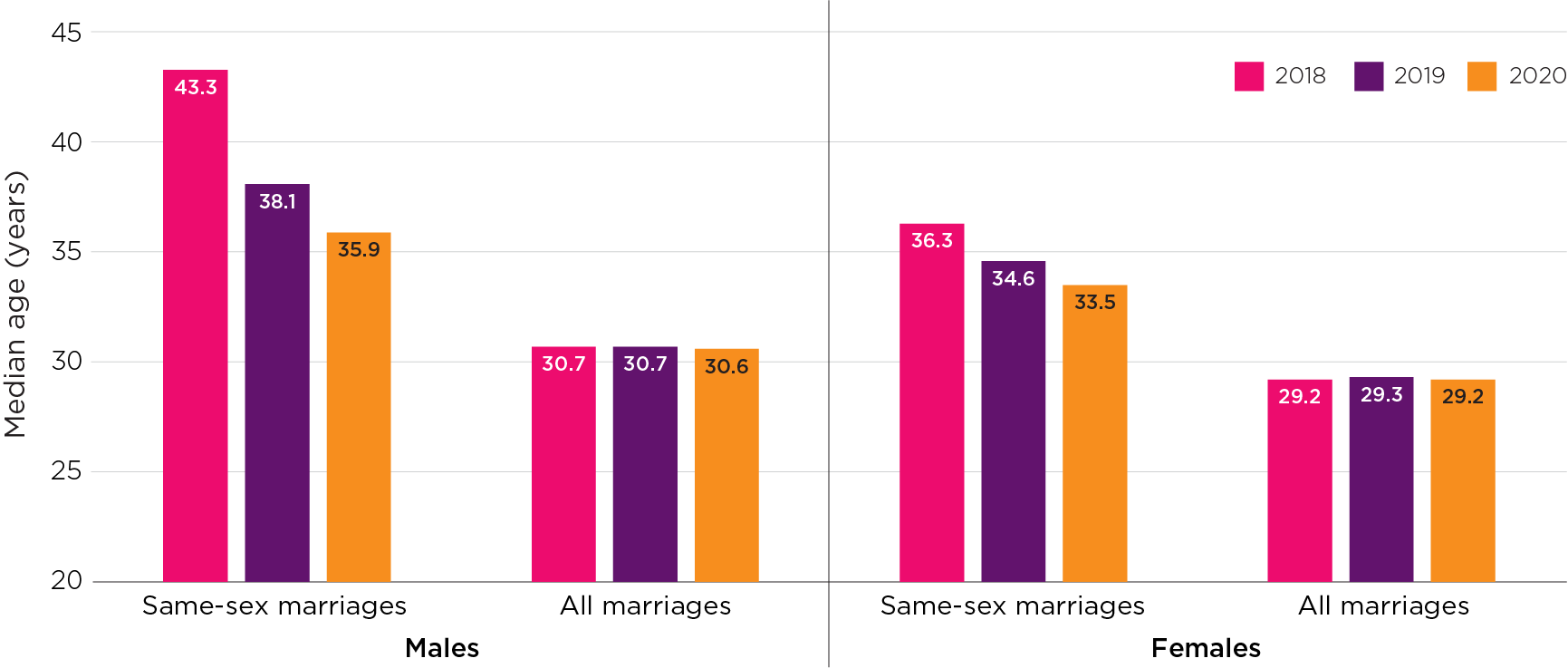
Sources: ABS, (2021), Marriages and Divorces Australia 2020
References
Australian Bureau of Statistics (ABS). (1997). Australian Social Trends (Catalogue No. 4102.0). Canberra: ABS.
Australian Bureau of Statistics. (2021). Marriages and Divorces Australia 2020. Canberra: ABS.
Australian Bureau of Statistics. (various years). Marriages and Divorces Australia. Canberra: ABS.
Australian Bureau of Statistics. (various years). Marriages Australia (Catalogue no. 3306.0). Canberra: ABS.
Commonwealth Bureau of Census and Statistics. (various years). Australian Demography Bulletin (ABS Catalogue No. 3141.0). Canberra: Commonwealth Bureau of Census and Statistics.
Weston, R., Stanton, D., Qu, L., & Soriano, G. (2001). Australian families in transition: Some socio-demographic trends 1901–2001. Family Matters, 60,12–23.
Weston, R., & Qu, L. (2014). Trends in family transitions, forms and functioning: Essential issues for policy development and legislation. In A. Hayes & D. Higgins (eds.), Families, policy and the law:
Selected essays on contemporary issues for Australia. Melbourne: Australian Institute of Family Studies.
1. In addition to restrictions on large gatherings, venue capacity limits and border closures, many states had specific restrictions on the number of guests attending weddings at some time during 2020. At the height of restrictions in Victoria, weddings were only permitted for compassionate reasons.